Young Eagles: The Story of a First Flight
I open my eyes and turn in bed to look out the window. I can see it’s a crisp, fall morning with a clear, bright blue sky-perfect flying weather. I learned this is the best time to fly … early morning just after sunrise when the weather still has the cool feel of nighttime. The air remains smooth with fewer bumps. I hurry to get dressed and run to the kitchen to eat my breakfast.
After eating, I jump up from the table and yell, “Mom, let’s go to the airport, I want to fly.”
At the airport, I leap out of the car and run to the hangar. I’m so excited. I’m finally going to take my first airplane ride in a small plane. I see the planes lined up. I later learn they are a Cessna, Piper, Cirrus, home built and more, ready to go. They each can hold from one to three passengers. I grab my mom’s hand as we see the volunteers setting up the desk and registration forms for the parents to sign.
Mom says to a volunteer, “I have two important questions. What does it cost for Danny to fly and is it safe.”
The volunteer answers. “It’s free. The EAA, Experimental Aircraft Association has been flying kids since 1992. So far, over 2 million young people from ages 8 to 17 have had airplane rides for free all over the United States. The pilots donate their time and their planes. It’s the only program of its kind, with the sole mission to introduce and inspire kids in the world of aviation. Each pilot is licensed by the Federal Aviation Administration (FAA) and all aircraft are likewise licensed by the government. The flights are conducted according to federal regulations.”
After mom registers and gives her permission, a volunteer pilot, Paul, says, “Come on over for the pre-flight, the walk around. You’ll learn what the pilot must do to be sure everything on the airplane works OK. The pilot does this check before every flight. Let’s take a look at how the airplane flies. You can get in the cockpit, the area where the pilot sits.”
I climb up and settle in the pilot’s seat in the airplane.
Paul tells me, “The wheel or stick inside the airplane moves to turn the airplane in the air.”
As I turn the wheel, he says “Look outside the plane at the wing and see the ailerons, the small part of the wing. It goes up and down whenever the wheel turns right or left. This is how the airplane turns in the air. Now push the wheel forward and back. As you do this, look at the tail of the plane, with the elevator and see it go up and down. This is how the plane goes up and down in the sky. Next, look at the rudder pedals on the floor. They look like gas pedals in a car. Push one at a time and look out the back of the plane to see the rudder on the tail move. The rudder helps to turn the plane on the ground and in the air. See that lever in the center of the panel in front of you? Push it down to let the flaps on the wings of the airplane go down. Here the pilot checks to be sure there are no obstructions that would interfere with the flap movement.”
“Wow, I see them moving down.” I say.
He helps me out of the plane and says, “Let’s go outside and we’ll do the final check. I’ll drain the fuel from a small opening under the plane to be sure we find no water or dirt in the fuel.”
All my questions are answered from how the fuel pump provides gas, to how the pilot talks on the radio. After the pre-flight, I am eager to fly.
Paul walks me to the airplane to be sure I don’t walk into the spinner and propeller, “A big deal when being around an airplane is safety first,” he says. “Don’t go near the propeller blades because if there is a problem, they may turn without warning and you can easily get hurt.”
In this Young Eagles program, the pilots enjoy introducing youngsters to the joys of flying as much as the kids do. It may be a man or woman, someone who flies for fun, uses the plane for their business, or someone who has spent his life as a commercial, professional pilot flying for the major airlines or the military. Diane, the pilot who is flying me today says, “Most kids want to sit up front with the pilot to be the co-pilot.”
As Diane helps me into the right seat of the plane, I see there are pillows on the seats, so I can reach the wheel and see out the plane.
“I’ll show you how to strap in with the seat belt just as you do in a car,” says Diane. “Then we’ll make sure the doors are shut tight.”
She gets in the plane and helps me put on a headset. “OK, all set, can you hear me OK? We are ready to taxi to the runway.”
Originally published at https://www.storymonsters.com on November 23, 2018.
